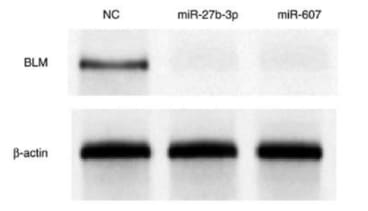Anti-BLM [BFL 103]
Invented by Helen Turley from University of Oxford
Invented at University of Oxford
- Datasheet
- References (7)
- Inventor Info
Info
| Catalogue Number | 151267 |
| Applications | ELISA IHC IF WB |
| Antigen/Gene or Protein Targets | Bloom’s Syndrome Protein (BLM) |
| Reactivity | Human |
| Relevance | BLM is the product of the Blooms syndrome gene and belongs to the RecQ family of DNA helicases. BLM is associated with an increase in the incidence of many types of cancer at an early age. |
| Host | Mouse |
| Immunogen | Recombinant Full Length Bloom’s Protein |
| Positive Control | Tonsil/thymus |
| Subclass | IgG1 |
| Myeloma Used | P3/NS1/1-Ag4.1 |
| Recommended Growing Conditions | RPMI + 10% FCS + HAT |
| Strain | Balb/c |
| Research Area | Cancer |
References: 7 entries
Chen et al. 2019. Mol Med Rep. 19(6):4819-4831. PMID: 30957187.
WB
Zhu et al. 2008. J Biol Chem. 283(43):29405-15. PMID: 18708356.
Small ubiquitin-related modifier (SUMO) binding determines substrate recognition and paralog-selective SUMO modification.
Europe PMC ID: 18708356
Turley et al. 2001. Br J Cancer. 85(2):261-5. PMID: 11461087.
The distribution and expression of the Bloom's syndrome gene product in normal and neoplastic human cells.
Europe PMC ID: 11461087
Wu et al. 2000. J Biol Chem. 275(13):9636-44. PMID: 10734115.
The Bloom's syndrome gene product interacts with topoisomerase III.
Europe PMC ID: 10734115
Add a reference
References: 7 entries
Chen et al. 2019. Mol Med Rep. 19(6):4819-4831. PMID: 30957187.
WB
Zhu et al. 2008. J Biol Chem. 283(43):29405-15. PMID: 18708356.
Small ubiquitin-related modifier (SUMO) binding determines substrate recognition and paralog-selective SUMO modification.
Turley et al. 2001. Br J Cancer. 85(2):261-5. PMID: 11461087.
The distribution and expression of the Bloom's syndrome gene product in normal and neoplastic human cells.
Wu et al. 2000. J Biol Chem. 275(13):9636-44. PMID: 10734115.
The Bloom's syndrome gene product interacts with topoisomerase III.
Add a reference





![Image thumbnail for Anti-BLM [BFL 103]](https://res.cloudinary.com/ximbio/image/upload/c_fit,fl_lossy,q_auto/2cd47fc7-87ac-4787-b7d7-a8a4a95a59fa.png)
![Image thumbnail for Anti-BLM [BFL 103]](https://res.cloudinary.com/ximbio/image/upload/c_fit,fl_lossy,q_auto/d4fb2224-490a-4930-b11c-ef767b060e0b.png)
![Image thumbnail for Anti-BLM [BFL 103]](https://res.cloudinary.com/ximbio/image/upload/c_fit,fl_lossy,q_auto/cce5ce91-f081-47a0-ad39-16b61c575f42.png)
![Image thumbnail for Anti-BLM [BFL 103]](https://res.cloudinary.com/ximbio/image/upload/c_fit,fl_lossy,h_45,q_auto/2cd47fc7-87ac-4787-b7d7-a8a4a95a59fa.png)
![Image thumbnail for Anti-BLM [BFL 103]](https://res.cloudinary.com/ximbio/image/upload/c_fit,fl_lossy,h_45,q_auto/d4fb2224-490a-4930-b11c-ef767b060e0b.png)
![Image thumbnail for Anti-BLM [BFL 103]](https://res.cloudinary.com/ximbio/image/upload/c_fit,fl_lossy,h_45,q_auto/cce5ce91-f081-47a0-ad39-16b61c575f42.png)

